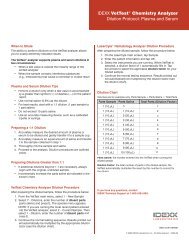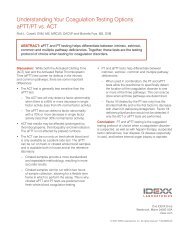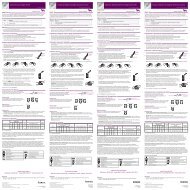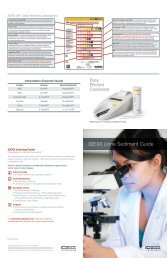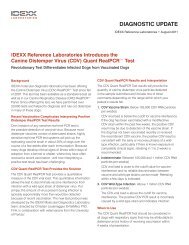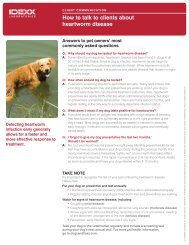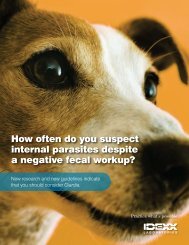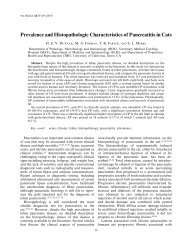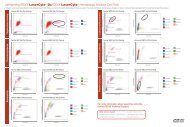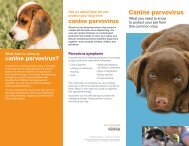Assessment of NTproBNP Concentration in Dogs - IDEXX ...
Assessment of NTproBNP Concentration in Dogs - IDEXX ...
Assessment of NTproBNP Concentration in Dogs - IDEXX ...
Create successful ePaper yourself
Turn your PDF publications into a flip-book with our unique Google optimized e-Paper software.
SMALL ANIMALS/EXOTICN-term<strong>in</strong>al pro-B-type natriuretic peptide is a cardiacbiomarker that is <strong>in</strong>creased <strong>in</strong> the blood <strong>of</strong> dogswith heart disease. 1,2 N-term<strong>in</strong>al pro-B-type natriureticpeptide is formed when its parent pro-hormone, pro-B-type natriuretic peptide, is cleaved <strong>in</strong>to 2 molecules,NT-proBNP and C-BNP. The pro-B-type natriuretic peptideis produced <strong>in</strong> response to an <strong>in</strong>crease <strong>in</strong> <strong>in</strong>tracardiachydrostatic pressure, <strong>in</strong>creased cardiac wall stress,angiotens<strong>in</strong> II, myocardial hypoxia, and heightenedsympathetic tone. 3 As such, both serum NT-proBNPand C-BNP concentrations represent potential diagnostictools to help diagnose congestive heart failure. 4,5 Inhumans, C-BNP 6–8 and NT-proBNP 9–11 assays possesshigh sensitivity and specificity <strong>in</strong> differentiat<strong>in</strong>g betweencardiac and pulmonary causes <strong>of</strong> respiratory distress.In circulation, C-BNP is rapidly degraded, 12 mak<strong>in</strong>glaboratory test<strong>in</strong>g difficult. Commercially availabletests <strong>in</strong> dogs and cats exclusively detect NT-proBNP,which is thought to possess a longer half-life.Results <strong>of</strong> a previous study 1 <strong>in</strong>dicate that dogs withrespiratory signs result<strong>in</strong>g from congestive heart failurehave significantly higher serum NT-proBNP concentrationsthan dogs with primary respiratory tract disease.The magnitude <strong>of</strong> difference between the 2 populationswas such that the serum NT-proBNP concentration provideda cl<strong>in</strong>ically useful test with an adequate sensitivityand specificity for differentiat<strong>in</strong>g between the 2 populations.However, all dogs did not undergo the sameset <strong>of</strong> diagnostic tests, and a substantial proportion <strong>of</strong>the study population lacked both evaluation <strong>of</strong> thoracicradiographs and an echocardiographic exam<strong>in</strong>ation.Thus, the usefulness <strong>of</strong> this peptide as an adjunct diagnostictest merits closer evaluation. We hypothesizedthat serum NT-proBNP concentration would be higher<strong>in</strong> dogs with congestive heart failure than <strong>in</strong> dogswith primary respiratory tract disease and that serumNT-proBNP concentration would help to differentiatebetween cardiac and noncardiac causes <strong>of</strong> respiratorysigns <strong>in</strong> dogs. The purpose <strong>of</strong> the multicenter studyreported here was to assess the cl<strong>in</strong>ical sensitivity andspecificity <strong>of</strong> a serum NT-proBNP assay to differentiatebetween cardiac versus noncardiac (ie, primary respiratorytract disease) causes <strong>of</strong> respiratory signs, and todeterm<strong>in</strong>e an optimal cut<strong>of</strong>f value that would facilitatethis assessment.Materials and MethodsAnimals—Study procedures were approved by the<strong>in</strong>stitutional animal use and care committees <strong>of</strong> eachqualify<strong>in</strong>g participat<strong>in</strong>g <strong>in</strong>stitution. Owner consent wasobta<strong>in</strong>ed for all dogs <strong>in</strong>cluded <strong>in</strong> the study. Fourteenveter<strong>in</strong>ary cardiology practices prospectively recruiteddogs between September 2006 and November 2007.<strong>Dogs</strong> were eligible for <strong>in</strong>clusion if the owner reported acompla<strong>in</strong>t <strong>of</strong> respiratory signs that were severe enoughto affect the dog’s quality <strong>of</strong> life. Qualify<strong>in</strong>g signs <strong>in</strong>cludedcough<strong>in</strong>g, stertor, stridor, excessive pant<strong>in</strong>g,<strong>in</strong>creased respiratory effort, tachypnea, or overt respiratorydistress. <strong>Dogs</strong> were excluded if respiratory signswere caused by obvious trauma (eg, vehicular trauma).<strong>Assessment</strong> <strong>of</strong> disease—All dogs underwentthoracic radiography and M-mode, 2-D, and Dopplerechocardiography. Vertebral heart size was measuredon the left or right lateral radiographic projection <strong>of</strong>the thorax by the attend<strong>in</strong>g cardiologist as previouslydescribed. 13,14 Additional diagnostic test<strong>in</strong>g to help determ<strong>in</strong>ethe underly<strong>in</strong>g cause <strong>of</strong> the respiratory signs(eg, fluoroscopy, tracheal wash, and bronchoscopy)was performed at the discretion <strong>of</strong> the attend<strong>in</strong>g cl<strong>in</strong>ician.The LVIDd, LVIDs, and LA:Ao were measured bymeans <strong>of</strong> standard echocardiographic techniques. 15,16Detection <strong>of</strong> tricuspid regurgitation by use <strong>of</strong> echocardiographywas recorded. Pulmonary hypertension wasarbitrarily def<strong>in</strong>ed as a velocity <strong>of</strong> tricuspid regurgitation> 3.25 m/s (pressure gradient > 42.3 mm Hg). Inthe absence <strong>of</strong> tricuspid regurgitation, a presumptiveechocardiographic diagnosis <strong>of</strong> pulmonary hypertensionwas made <strong>in</strong> dogs with a comb<strong>in</strong>ation <strong>of</strong> severeright ventricular hypertrophy or dilation, flattened<strong>in</strong>terventricular septum, and an enlarged ma<strong>in</strong> pulmonaryartery, <strong>in</strong> the absence <strong>of</strong> <strong>in</strong>creased right ventricularto pulmonary artery outflow velocity.A standardized patient datasheet was used to recordpatient signalment, cl<strong>in</strong>ical signs, and diagnosticf<strong>in</strong>d<strong>in</strong>gs. On the basis <strong>of</strong> this workup, and withoutknowledge <strong>of</strong> the NT-proBNP assay results, a boardcertifiedveter<strong>in</strong>ary cardiologist assigned the dog to 1<strong>of</strong> 4 groups as follows: group 1 <strong>in</strong>cluded dogs with congestiveheart failure (f<strong>in</strong>d<strong>in</strong>gs <strong>of</strong> severe cardiac disease,perihilar or caudodorsal pulmonary <strong>in</strong>terstitial pattern,cardiomegaly, enlarged pulmonary ve<strong>in</strong>s, pleural effusion,and ascites) and without primary respiratory tractdisease; group 2 <strong>in</strong>cluded dogs with primary respiratorytract disease (parenchymal lung disease [f<strong>in</strong>d<strong>in</strong>gs<strong>of</strong> cranioventral or lobar alveolar pattern, lung lobe torsion,and bullae] or upper airway disease [f<strong>in</strong>d<strong>in</strong>gs <strong>of</strong>laryngeal paralysis, brachycephalic syndrome, collaps<strong>in</strong>gtrachea, and moderate or severe bronchiolar pulmonarypattern]) and without underly<strong>in</strong>g cardiac disease(no heart murmur and no evidence <strong>of</strong> cl<strong>in</strong>ically relevantleft-sided cardiac disease on echocardiography); group3 <strong>in</strong>cluded dogs with primary respiratory tract disease(as described for group 2 dogs) that also had heart diseasethat was not congestive heart failure (detection <strong>of</strong>heart murmur or cardiac disease on echocardiographywithout evidence <strong>of</strong> congestive heart failure on thoracicradiography, physical exam<strong>in</strong>ation, or other diagnostictests); and group 4 <strong>in</strong>cluded dogs for which the etiology<strong>of</strong> respiratory signs could not be reliably ascribedto either respiratory tract disease or congestive heartfailure.Measurement <strong>of</strong> serum NT-proBNP concentration—Venousblood samples were collected at the time<strong>of</strong> admission. Blood was drawn <strong>in</strong>to pla<strong>in</strong> evacuatedglass tubes that did not conta<strong>in</strong> any additives. Sampleswere centrifuged with<strong>in</strong> 60 m<strong>in</strong>utes after collection,and serum was stored at –20°C prior to batched overnightshipment for analysis. Samples were shipped withcold packs and pack<strong>in</strong>g materials provided by the assaymanufacturer. Serum NT-proBNP concentration wasdeterm<strong>in</strong>ed with a commercially available can<strong>in</strong>e-specificNT-proBNP assay a as previously described. 2Statistical analysis—Data were summarized asmedian (IQR [ie, 25th to 75th percentile]) or mean ±1320 Scientific Reports JAVMA, Vol 235, No. 11, December 1, 2009



